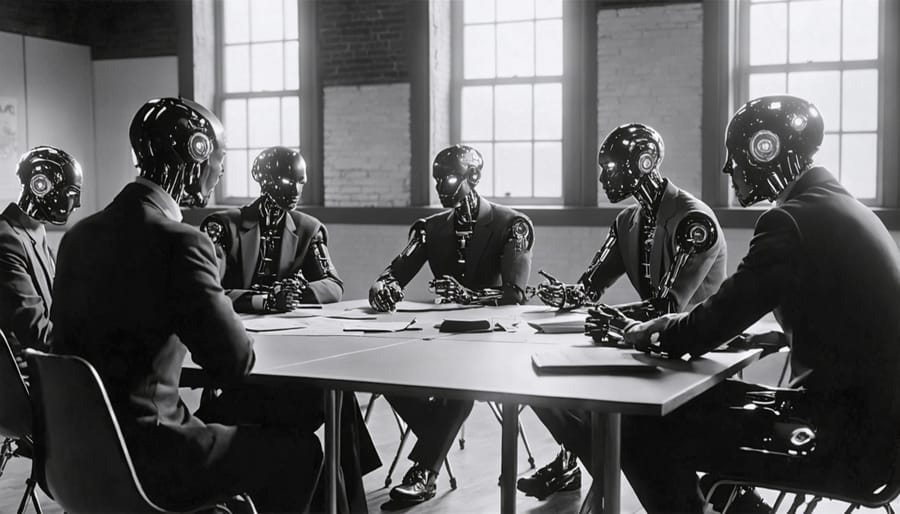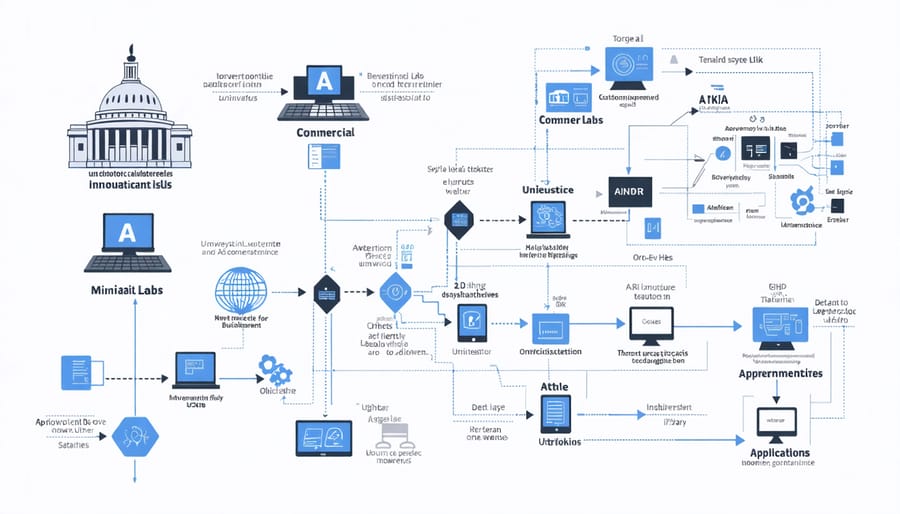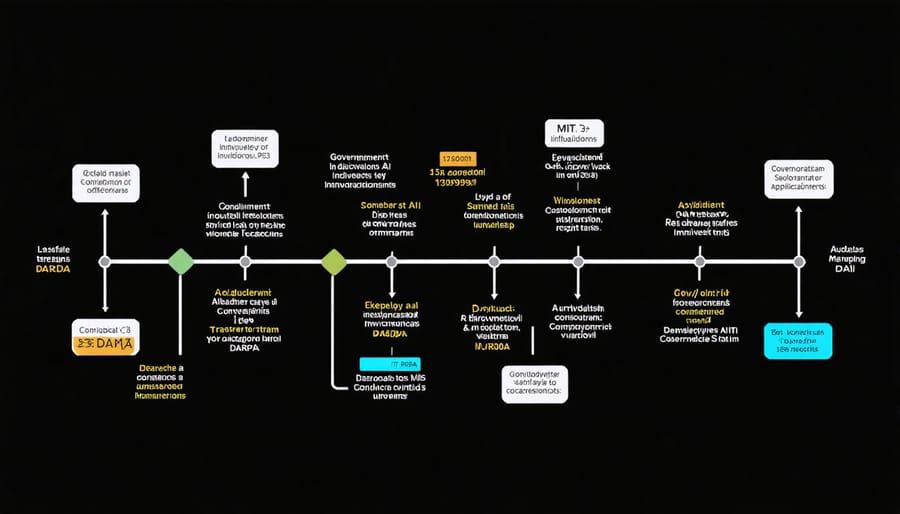From its humble beginnings in the 1950s to today’s sophisticated systems, artificial intelligence has transformed from an academic curiosity into a revolutionary force reshaping our world. The journey of AI development, marked by early AI breakthroughs, reflects humanity’s enduring quest to create machines that can think and learn. At institutions like MIT, Stanford, and Carnegie Mellon, pioneering researchers laid the groundwork for what would become a technological revolution, developing foundational concepts in neural networks, machine learning, and natural language processing.
Today, AI powers everything from smartphone assistants to autonomous vehicles, with recent advances in deep learning and neural networks pushing the boundaries of what’s possible. The field has evolved from rule-based systems to sophisticated algorithms capable of recognizing patterns, making decisions, and even generating creative content. This rapid progression hasn’t just changed technology – it’s revolutionizing healthcare, finance, transportation, and countless other industries.
As we stand at the cusp of even more remarkable developments in AI, understanding its historical evolution helps us better appreciate both its current capabilities and future potential. The convergence of increased computing power, vast datasets, and refined algorithms continues to accelerate AI’s development, promising even more extraordinary innovations ahead.
The Birth of AI in Academic Corridors
The Dartmouth Conference
In the summer of 1956, a groundbreaking eight-week gathering at Dartmouth College marked the official birth of artificial intelligence as a field. The conference, organized by John McCarthy, Marvin Minsky, Nathaniel Rochester, and Claude Shannon, brought together leading scientists and mathematicians to explore ways machines could simulate human intelligence.
The proposal for the conference was remarkably ambitious, suggesting that “every aspect of learning or any other feature of intelligence can be so precisely described that a machine can be made to simulate it.” This bold vision set the stage for decades of AI research to follow.
During the conference, participants worked on various problems, including natural language processing, neural networks, and theory of computation. While the immediate outcomes might have fallen short of the organizers’ lofty goals, the conference succeeded in establishing AI as a distinct academic discipline and creating a community of researchers dedicated to the field.
The terminology “artificial intelligence” itself was coined by McCarthy for this conference, giving the field its enduring name. The Dartmouth Conference’s legacy continues to influence modern AI development, with many of its original questions about machine intelligence still relevant today.

Early University Research Centers
The birth of modern artificial intelligence can be traced to three pioneering research centers established in the late 1950s and early 1960s. The MIT Artificial Intelligence Laboratory, founded by John McCarthy and Marvin Minsky, became the epicenter of early AI research, developing groundbreaking programming languages like LISP that would become fundamental to AI development.
At Stanford University, the Stanford Artificial Intelligence Laboratory (SAIL) emerged under the leadership of John McCarthy after his departure from MIT. SAIL researchers made significant contributions to computer vision, robotics, and natural language processing, though they faced numerous challenges in AI development along the way.
Carnegie Mellon University’s Computer Science Department, led by Allen Newell and Herbert Simon, focused on developing general problem-solving programs and laid the groundwork for expert systems. Their Logic Theorist program, considered the first artificial intelligence program, successfully proved mathematical theorems and demonstrated that machines could engage in complex reasoning tasks.
These institutions fostered collaboration, innovation, and the exchange of ideas that would shape the future of artificial intelligence, establishing the foundation for modern AI research and applications.
Government’s Cold War AI Investment
DARPA’s Crucial Role
DARPA, the Defense Advanced Research Projects Agency, has been instrumental in shaping the landscape of artificial intelligence since the 1960s. As a pioneering force in technological innovation, DARPA’s substantial funding and forward-thinking initiatives transformed early AI concepts into practical applications.
During the Cold War era, DARPA invested heavily in natural language processing and computer vision projects, recognizing their potential military applications. The agency’s landmark initiatives included the Strategic Computing Program of the 1980s, which allocated over $1 billion to advance AI capabilities, focusing on autonomous vehicles, expert systems, and battlefield management tools.
One of DARPA’s most significant contributions was its support of neural network research when the field faced skepticism. The agency continued funding these projects through the “AI winter” of the 1970s, helping maintain crucial momentum in the field. This persistence ultimately led to breakthroughs in machine learning algorithms that we still use today.
DARPA’s influence extends beyond direct research funding. The agency created networks connecting researchers across universities and industries, fostering collaboration and knowledge sharing. Many modern AI technologies, including speech recognition, autonomous navigation, and expert systems, can trace their roots to DARPA-funded projects.
Today, DARPA continues to drive AI innovation through programs like the AI Next campaign, investing billions in developing trustworthy AI systems and pushing the boundaries of machine learning capabilities. Their ongoing commitment to AI research remains vital for advancing the field and maintaining technological leadership.

Military Applications
The military played a pivotal role in advancing artificial intelligence during its early stages. In the 1950s and 1960s, the U.S. Department of Defense invested heavily in AI research through agencies like DARPA (Defense Advanced Research Projects Agency), recognizing its potential for strategic applications.
One of the earliest military AI projects was the SAGE (Semi-Automatic Ground Environment) system, developed to detect and track Soviet bombers. This massive computer network demonstrated how machines could process real-time data and assist in decision-making, laying groundwork for modern air defense systems.
These military investments yielded unexpected civilian benefits. Pattern recognition algorithms originally designed for target identification found applications in medical imaging. Natural language processing, developed for code-breaking and intelligence analysis, later became fundamental to modern translation software and virtual assistants.
The military’s focus on robotics and autonomous systems also accelerated development in civilian sectors. Technologies initially created for unmanned reconnaissance vehicles evolved into self-driving cars and industrial automation systems. Machine learning algorithms designed for tactical planning now power everything from logistics optimization to financial trading systems.
While military applications raised ethical concerns, their technological spillovers significantly shaped modern AI development. This partnership between military research and civilian innovation continues today, driving advances in areas like cybersecurity, autonomous systems, and predictive analytics.
The Public-Private Partnership Era

Technology Transfer Success Stories
One of the most remarkable success stories in AI technology transfer is IBM’s Watson, which evolved from a research project to revolutionizing healthcare diagnostics and business analytics. Originally designed to compete on Jeopardy!, Watson now assists doctors in diagnosis and treatment recommendations across numerous hospitals worldwide.
Another notable example is the development of deep learning algorithms at the University of Toronto, which led to the creation of AlexNet in 2012. This breakthrough in image recognition quickly transitioned from academic research to power numerous modern AI applications, from facial recognition systems to autonomous vehicles.
Google’s acquisition of DeepMind represents another successful transition from research to commercial application. Their AI system AlphaGo, which famously defeated world champion Go player Lee Sedol, has since evolved into AlphaFold, making groundbreaking discoveries in protein structure prediction that benefit medical research and drug development.
Speech recognition technology, initially developed at Carnegie Mellon and Stanford, has successfully transformed into virtual assistants like Siri and Alexa, demonstrating how fundamental research can lead to widespread consumer applications.
Research Funding Models
The development of AI has been driven by diverse funding models, each shaping the direction and pace of innovation. Government agencies, particularly DARPA in the United States, have historically been major contributors, providing substantial grants for fundamental research at universities and research institutions. This approach helped establish the foundational theories and technologies that power modern AI systems.
Private sector funding has grown exponentially since the 2010s, with tech giants like Google, Microsoft, and Meta investing billions in AI research and development. This corporate funding tends to focus on practical applications and commercial viability, often leading to faster deployment of AI technologies in real-world scenarios.
A newer model gaining traction is the public-private partnership, where government resources combine with corporate expertise and funding. Organizations like OpenAI initially started as non-profit entities before adopting hybrid structures to balance ethical AI development with commercial sustainability.
Venture capital has also played a crucial role, particularly in funding AI startups and specialized research. This model has accelerated innovation but sometimes raises concerns about prioritizing short-term results over long-term scientific advancement.
Legacy and Modern Impact
The foundational work in artificial intelligence, primarily conducted by government agencies and academic institutions during the 1950s and 1960s, continues to have a profound impact on current AI technologies. Many of the algorithms and approaches developed during this period remain relevant in modern AI applications.
For instance, the basic principles of neural networks, first explored at institutions like MIT and Stanford, form the backbone of today’s deep learning systems that power everything from facial recognition to language translation. The pattern recognition techniques developed by early researchers at Carnegie Mellon University are now essential components in computer vision and autonomous vehicles.
Government-funded research, particularly through DARPA, established crucial frameworks for knowledge representation and problem-solving that continue to influence modern AI architectures. The emphasis on mathematical logic and symbolic reasoning from this era has evolved into today’s expert systems and decision-making algorithms.
Perhaps most significantly, the collaborative model between government, academia, and industry established during these early years remains the template for modern AI innovation. This three-way partnership continues to drive breakthroughs in areas like machine learning, robotics, and natural language processing, demonstrating how early theoretical foundations have transformed into practical applications that impact our daily lives.

